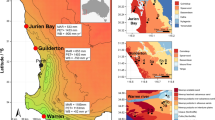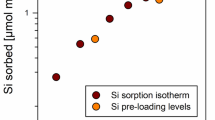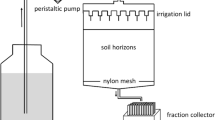Abstract
Dissolved Si (DSi) provision from land systems triggers diatom growth and CO2 sequestration. Soils and ecosystems act as a Si “filter”, transforming DSi originated from mineral weathering into biogenic Si (BSi) after DSi uptake by plants, or into other pedogenic forms of Si (non-BSi). Land use changes the quantity of BSi and non-BSi pools along the soil profile. However, methods used to isolate Si pools include chemical extractions at high temperatures and alkaline environments and therefore are unable to provide information concerning the dissolution potential of BSi and non-BSi pools under normal conditions of temperature and pH. Here, we conducted a batch experiment where forest, pasture and cropland soil samples were mixed with water at 25 °C and pH 7. The soil samples were collected from a temperate land use gradient located in the Belgian Loess Belt. We measured dissolved Si and aluminium (Al) during 80 days. BSi and non-BSi pool contents along the soil profile were known, as they had been established previously through chemical extraction. Results show that BSi and non-BSi enriched samples present distinct Si and Al dissolution curves. While non-BSi pools contribute significantly with immediate availability of Si, BSi pools present an initial slow dissolution. Therefore, croplands that were depleted of phytoliths and had poorly organic horizons display higher concentrations of initial dissolved Si, while pastures and forests, where pedogenic pools dominate only at depths below 40 cm, have more limited initial Si release.
Similar content being viewed by others
References
Conley DJ, Carey JC (2015) Silica cycling over geologic time. Nat Publ Group 8:431–432
Berner AR, Lasaga AC, Garrels RM (1983) The carbonate silicate geochemical cycle and its effect on atmosphere carbon dioxide over the past 100 million years. Am J Sci 283:641–683
Beaulieu E, Goddéris Y, Donnadieu Y, Labat D, Roelandt C (2012) High sensitivity of the continental-weathering carbon dioxide sink to future climate change. Nat Clim Chang 2:346–349
Tréguer PJ, De La Rocha CL (2013) The world ocean silica cycle. Annu Rev Mar Sci 5:477–501. https://doi.org/10.1146/annurev-marine-121211-172346
Conley DJ (1997) Riverine contribution of biogenic silica to the oceanic silica budget. Limnol Oceanogr 42:774–777
Smis A, Damme S, Struyf E et al (2010) A trade-off between dissolved and amorphous silica transport during peak flow events (Scheldt river basin, Belgium): impacts of precipitation intensity on terrestrial Si dynamics in strongly cultivated catchments. Biogeochemistry 106:475–487
Conley DJ (2002) Terrestrial ecosystems and the global biogeochemical silica cycle. Glob Biogeochem Cycles 16:1121
Carey JC, Fulweiler RW (2012) The terrestrial silica pump. PLoS One 7:e52932. https://doi.org/10.1371/journal.pone.0052932
Struyf E, Conley DJ (2012) Emerging understanding of the ecosystem silica filter. Biogeochemistry 107:9–18
Alexandre A, Meunier J-D, Colin F, Koud J-M (1997) Plant impact on the biogeochemical cycle of silicon and related weathering processes. Geochim Cosmochim Acta 61:677–682
Piperno D (2006) Phytoliths: a comprehensive guide for archaeologists and Paleoecologists, Altamira Press, Oxford
Guntzer F, Keller C, Meunier J-D (2011) Benefits of plant silicon for crops: a review. Agron Sustain Dev 32:201–213
Bartoli F, Wilding LP (1980) Dissolution of biogenic opal as a function of its physical and chemical properties. Soil Sci Soc Am J 44:873–878
Fraysse F, Pokrovsky OS, Meunier J-D (2010) Experimental study of terrestrial plant litter interaction with aqueous solutions. Geochim Cosmochim Acta 74:70–84
Cornelis J-T, Weis D, Lavkulich L et al (2014) Silicon isotopes record dissolution and re-precipitation of pedogenic clay minerals in a podzolic soil chronosequence. Geoderma 235–236:19–29
Cornelis JT, Dumon M, Tolossa AR, Delvaux B, Deckers J, van Ranst E (2014) The effect of pedological conditions on the sources and sinks of silicon in the Vertic Planosols in South-Western Ethiopia. Catena 112:131–138
Sommer M, Kaczorek D, Kuzyakov Y, Breuer J (2006) Silicon pools and fluxes in soils and landscapes—a review. J Plant Nutr Soil Sci 169:310–329
Ronchi B, Clymans W, Barão ALP, Vandevenne F, Struyf E, Batelaan O, Dassargues A, Govers G (2013) Transport of dissolved Si from soil to river: a conceptual mechanistic model. Silicon 5:115–133
Georgiadis A, Sauer D, Herrmann L, Breuer J, Zarei M, Stahr K (2014) Testing a new method for sequential silicon extraction on soils of a temperate-humid climate. Soil Res 52:645
Barão L, Vandevenne F, Clymans W, Frings P, Ragueneau O, Meire P, Conley DJ, Struyf E (2015) Alkaline-extractable silicon from land to ocean: a challenge for biogenic silicon determination. Limnol Oceanogr Methods 13:329–344. https://doi.org/10.1002/lom3.10028
Blecker SW, McCulley RL, Chadwick OA, Kelly EF (2006) Biologic cycling of silica across a grassland bioclimosequence. Global Biogeochem Cycles 20:1–11
Cornelis JT, Titeux H, Ranger J, Delvaux B (2011) Identification and distribution of the readily soluble silicon pool in a temperate forest soil below three distinct tree species. Plant Soil 342:369–378
Struyf E, Smis A, Van Damme S et al (2010) Historical land use change has lowered terrestrial silica mobilization. Nat Commun 1:129
Vandevenne F, Struyf E, Clymans W, Meire P (2012) Agricultural silica harvest: have humans created a new loop in the global silica cycle? Front Ecol Environ 10:243–248
Barão L, Clymans W, Vandevenne F, Meire P, Conley DJ, Struyf E (2014) Pedogenic and biogenic alkaline-extracted silicon distributions along a temperate land-use gradient. Eur J Soil Sci 65:693–705
Unzué-Belmonte D, Ameijeiras-Mariño Y, Opfergelt S, Cornelis JT, Barão L, Minella J, Meire P, Struyf E (2017) Land use change affects biogenic silica pool distribution in a subtropical soil toposequence. Solid Earth 8:737–750
Keller C, Guntzer F, Barboni D, Meunier J (2012) Impact of agriculture on the Si biogeochemical cycle : input from phytolith studies. Compt Rendus Geosci 344:739–746
Vandevenne FI, Barão L, Ronchi B, Govers G, Meire P, Kelly EF, Struyf E (2015) Silicon pools in human impacted soils of temperate zones. Glob Biogeochem Cycles 29:1439–1450
Greenwood JE, Truesdale VW, Rendell a R (2001) Biogenic silica dissolution in seawater — in vitro chemical kinetics. Prog Oceanogr 48:1–23
Koning E, Epping E, van RW (2002) Determining biogenic silica in marine samples by tracking silicate and aluminium concentrations in alkaline leaching solutions. Aquat Geochem 8:37–67
Clymans W, Barão L, Van Der Putten N et al (2015) The contribution of tephra constituents during biogenic silica determination: implications for soil and palaeoecological studies. Biogeosciences 12:3789–3804
Saccone L, Conley DJ, Koning E, Sauer D, Sommer M, Kaczorek D, Blecker SW, Kelly EF (2007) Assessing the extraction and quantification of amorphous silica in soils of forest and grassland ecosystems. Eur J Soil Sci 58:1446–1459
Ronchi B, Barão L, Clymans W, Vandevenne F, Batelaan O, Govers G, Struyf E, Dassargues A (2015) Factors controlling Si export from soils : a soil column approach. Catena 133:85–96
Clymans W, Struyf E, Govers G, Vandevenne F, Conley DJ (2011) Anthropogenic impact on amorphous silica pools in temperate soils. Biogeosciences 8:2281–2293
Berggren D, Mulder J (1995) The role of organic matter in controlling aluminum solubility in acidic mineral soil horizons. Geochim Cosmochim Acta 59:4167–4180
Schaetzl RJ, Anderson S (2005) Soils genesis and geomorphology. Cambridge University Press, New York
Tisdall JM, Oades JM (1982) Organic matter and water-stable aggregates in soils. J Soil Sci 33:141–163
Hudson B (1994) Soil organic matter and available water capacity. J Soil Water Conserv 49:189–194
Lugtenberg B, Kamilova F (2009) Plant-growth-promoting Rhizobacteria. Annu Rev Microbiol 63:541–556
Bhattacharyya PN, Jha DK (2012) Plant growth-promoting rhizobacteria (PGPR): emergence in agriculture. World J Microbiol Biotechnol 28:1327–1350
Cornelis JT, Delvaux B (2016) Soil processes drive the biological silicon feedback loop. Funct Ecol 30:1298–1310
Guntzer F, Keller C, Poulton PR, McGrath SP, Meunier JD (2012) Long-term removal of wheat straw decreases soil amorphous silica at Broadbalk, Rothamsted. Plant Soil 352:173–184
Barão L, Alaoui A, Ferreira C, Basch G, Schwilch G, Geissen V, Sukkel W, Lemesle J, Garcia-Orenes F, Morugán-Coronado A, Mataix-Solera J, Kosmas C, Glavan M, Pintar M, Tóth B, Hermann T, Vizitiu OP, Lipiec J, Reintam E, Xu M, di J, Fan H, Wang F (2019) Assessment of promising agricultural management practices. Sci Total Environ 649:610–619
Klotzbücher T, Klotzbücher A, Kaiser K, Merbach I, Mikutta R (2018) Impact of agricultural practices on plant-available silicon. Geoderma 331:15–17
Acknowledgements
L. Barão was supported by grant SFRH/BPD/115681/2016 and R.F.M. Teixeira by grant SFRH/BPD/111730/2015 from Fundação para a Ciência e Tecnologia (FCT).
Author information
Authors and Affiliations
Corresponding author
Additional information
Publisher’s Note
Springer Nature remains neutral with regard to jurisdictional claims in published maps and institutional affiliations.
Rights and permissions
About this article
Cite this article
Barão, L., Teixeira, R., Vandevenne, F. et al. Silicon Mobilization in Soils: the Broader Impact of Land Use. Silicon 12, 1529–1538 (2020). https://doi.org/10.1007/s12633-019-00245-y
Received:
Accepted:
Published:
Issue Date:
DOI: https://doi.org/10.1007/s12633-019-00245-y




